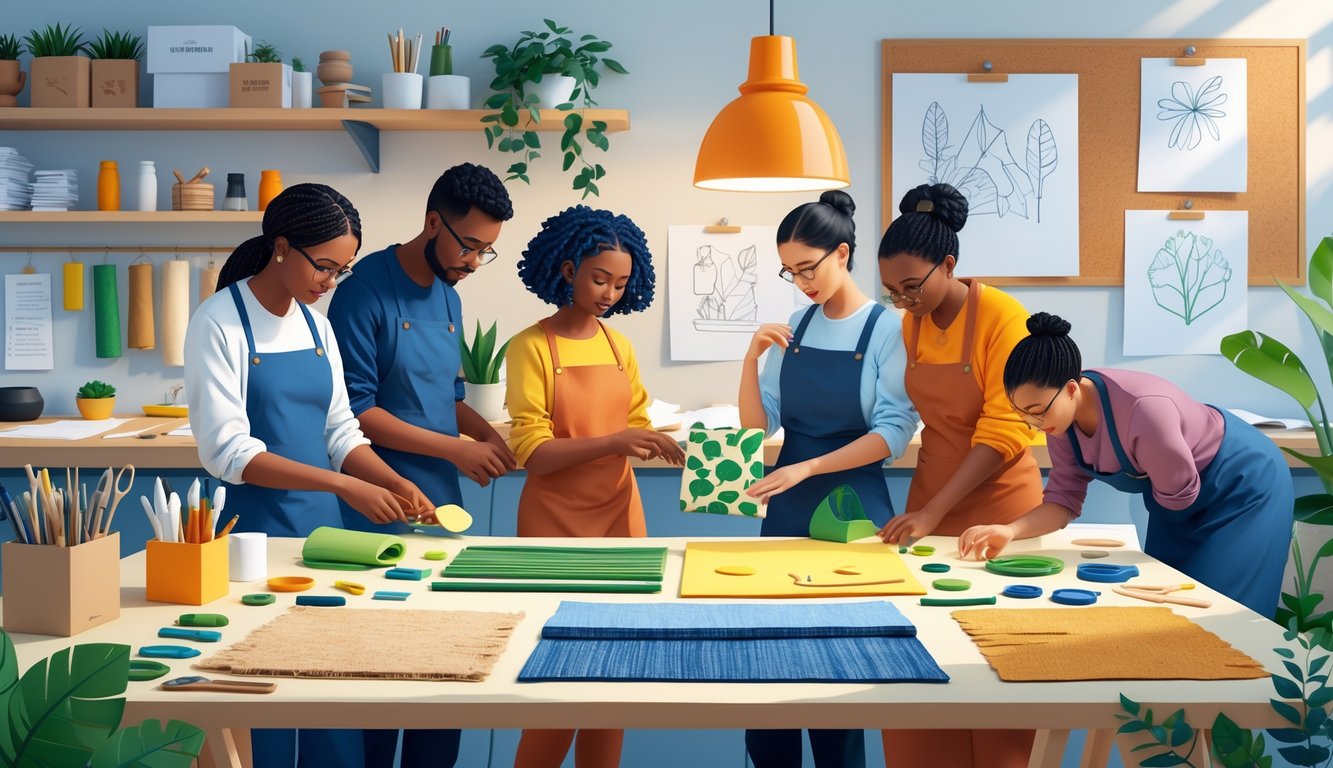
Applications Across Popular Crafting Techniques
Swapping in these alternatives isn’t magic. Some things just finally don’t feel tacky, you know? What works for one project is a total disaster for another, so pay attention or you’ll end up with the world’s saddest DIY fail pile.
Jewelry Making and Resin Alternatives
Okay, so why are people still messing with classic epoxy? Seriously, are they just ignoring all the new resin swaps? I can’t stop noticing it—my friend (the one who stains her hands with turmeric, don’t ask) finishes pendants with plant-based resins. She’s obsessed. Always comparing it to the old stuff, like she’s running a science fair in her kitchen.
So, Pebeo—yeah, I’m naming names—makes this bio-sourced resin that doesn’t yellow much. It’s not perfect, but I don’t get a headache using it indoors. Have you ever tried sanding epoxy with a toddler around? I’d rather juggle knives. Stats from Pebeo’s product sheet say 70% renewable content, which… is better than nothing. Acrylic resin? High-shine but goes brittle if you rush it. And, no, blasting it with a lamp doesn’t make it cure faster—learned that the sticky way.
Upcycled clear PLA filament is the wild card. Some people call it “eco-resin.” It melts if you leave it in the sun. Earrings? Nope. I’d maybe use it for brooch backs, but if you like your earrings falling off at brunch, go for it.
Fabric and Quilting Innovations
Tried those “organic” bamboo batting things. I get the hype—less itching, supposedly hypoallergenic. But honestly, hemp-blend fabric makes me sweat more, and it doesn’t breathe like everyone claims. Washed a throw blanket a dozen times and had to toss it after one season. If you check out this shift in materials, lyocell (Tencel) is taking over. The color stays, almost suspiciously well.
Acetate blends from thrifted clothes? I know people who love them, but unless you have micro-serrated scissors, you’ll wreck the edges. And “eco-fabric” labels—half of them are nonsense. Isadora Textiles? I’ve had decent luck. Their color sticks around, even after 40 washes (according to some trade report, anyway). Batting from old wool sweaters? Shrinks unevenly. Take a photo first if you care about your project. Oh, and linen scraps from fabric stores? They’re usually better than those IKEA kits, especially if you want that heritage, textured vibe. My friend swears by her method, but she still curses about fraying at least half the time.
Paper and Glass Crafting
Paper mulberry. Why is it always so expensive? I’ve seen pros swear by hand-beaten kozo for restoration, but for daily stuff, it feels like a flex. Found a recycled cotton rag paper—140lb, good tooth for block printing, and no feathering with pigment ink, even in humidity. The WORTH Project did some workshops mixing recycled pulps with digital embossing; I got invited, didn’t go, kind of regret it. Apparently, you can embed lavender and still print cleanly. I’m skeptical, but whatever.
Glass? Not my favorite. Soda-lime glass from food jars sounds thrifty until you chip your Dremel blade, and then you’re just mad. Polymer “glass” like UV-cured acrylics—don’t even try it for mug handles, but for sun catchers or fake stained-glass? Actually decent. Melting “sea glass” in toaster ovens is a disaster—sticky mess every time. Just get recycled-cullet fusing glass if you’re serious. Arkanite’s batch is reliable, but you need a real kiln. Not your candle warmer. Trust me.
Upcycling and Recycling in Crafting
People keep dumping “craftable” trash at the maker space. Ted (the bottle cap guy) claims it’s all gold. Upcycling jewelry sounds great, but most bottle cap earrings are uncomfortable and look like you lost a bet. WORTH’s initiative says “sustainable meets design,” but I’ve jammed plastic mesh bags in a serger enough times to stay skeptical.
Repurposed fabric from estate sales—half polyester—sews fine but don’t freak out when seams stretch weird. Cereal box liners as stencils? Kinda works, but they attract static and you’ll be picking glitter off everything for days. Tried making glass tile mosaics from old screens. Looks cool, but my fingers still have scars.
Is the lesson that upcycling is noble? Or are we just too stubborn to toss stuff out? The amount of stuff getting a second life—attic textiles, “rustic” bottle glass—has doubled, according to Craft Industry Alliance’s Spring 2024 survey. That’s something, I guess. But if I see one more wind chime, I’m out.
Strength, Durability, and Performance of Material Alternatives
New alternatives keep showing up—half the time I don’t know if I should be excited or suspicious. Some look and feel legit, but then my wool hat shrinks next to bamboo rayon that couldn’t care less about the wash temp. Is that normal?
Strong and Durable Options
Concrete alternatives in crafts? Sounds like a joke, but eco mixes with recycled fly ash or hempcrete actually hit real compressive strengths. I argued with myself about whether this mushroom-based composite was actually solid or if I was just convincing myself. My craft group? No one believed the tensile test numbers—400 psi on one product. “Impossible!” But nobody countered.
Try telling a knitter that plant-based acrylic yarns outlast bargain wool. Cambridge Materials Institute said in 2024 that some soy-protein fibers now match or beat cheap wool for abrasion. No one can tell by touch, though. My neighbor’s “biodegradable” tote lasted two years in the snow, so what even is “durable” now? Sunlight still destroys non-dyed cotton, though. Here’s a quick table, because why not:
| Material | Reported Strength | Abrasion Resistance | Water Tolerance |
|---|---|---|---|
| Concrete Alt. | 4000+ psi | High | Excellent |
| Wool | Moderate | Moderate/High | Fair |
| Soy Fiber | 425 psi | High | Good |
Comparing Longevity in Finished Projects
Wardrobe stuff: wool’s tricky. My grandma’s 1960s sweater outlasted three “eco” sweatshirts my brother trashed in six months. Hemp-linen sheets? Three years, barely any thinning. “Sturdy” fast-fashion cotton? Dead after 15 washes. Bamboo yarn actually lasted longer than my favorite pure wool scarf, which moths destroyed in two winters.
GreenBuilder Media’s 2024 review said new sustainable panels outlasted traditional insulation—if the installer didn’t screw up the vapor barrier. Wool batting? If you don’t treat it for pests, you’re doomed. Google “sheep’s wool insulation disaster” if you want nightmares. Performance spec sheets say it’s less about the material, more about how you use and care for it. But who’s tracking that? Eco-panels in damp basements didn’t warp, but “advanced mycelium” cladding warped in one rainy week. Durability’s a moving target—wool, hemp concrete, biofiber—it all ends up in the trash if it fails mid-season.
If you want to dive into construction durability and material performance, there are guides, but none tell you how to feel when a $14 “sustainable” tote outlasts your baby blanket.



